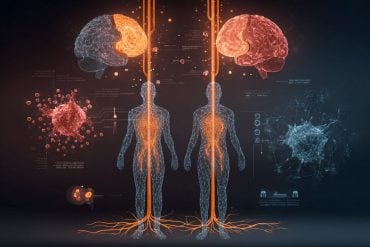Summary: Researchers have discovered that a gene called CHRNA3 plays a key role in determining alcohol sensitivity, helping explain why some people tolerate alcohol better than others. When this gene was mutated, subjects were slower to avoid alcohol and consumed more of it, showing reduced sensitivity to its calming effects.
The mutation also altered brain signaling pathways involving glutamate and GABA, both crucial for balancing excitation and inhibition. These findings suggest that variations in CHRNA3 could increase vulnerability to alcohol dependence, providing new insight into genetic risk factors for addiction.
Key Facts
- Alcohol Sensitivity Gene: CHRNA3 regulates how strongly the brain responds to alcohol’s effects.
- Mutation Impact: Altered CHRNA3 delays alcohol avoidance and promotes higher intake.
- Addiction Insight: The gene’s function may underlie genetic predispositions to alcohol use disorders.
Source: NUS
Researchers from the Yong Loo Lin School of Medicine at the National University of Singapore (NUS Medicine) report that the gene, CHRNA3, acts as a key regulator of alcohol sensitivity.
Published in the Journal of Neuroscience, the study provides long-sought experimental evidence to back up human genetic studies, linking CHRNA3 function changes to measurable differences in innate alcohol sensitivity.

The study was led by Associate Professor Ajay S. Mathuru from the Department of Physiology at NUS Medicine with first author, Dr. Joshua Raine, Research Fellow, and Dr. Caroline Kibat, Senior Research Fellow, from the same department.
The team found that mutations in the gene chrna3, a nicotinic acetylcholine receptor gene expressed in the nervous system, are associated with lowered sensitivity to alcohol in a preclinical laboratory model.
To determine if genetic factors can contribute to developing alcohol use disorders, the researchers utilised a two-choice assay where it is possible to self-administer alcohol voluntarily. They quantified avoidance versus attraction behaviour and analysed brain gene expression for key neurotransmitter receptors.
In normal conditions, brief attraction to alcohol followed by rapid avoidance as the dose rises, was observed. In contrast, preclinical laboratory models with mutations in chrna3 delay this switch to avoidance, self-administering alcohol for much longer and tolerating higher concentrations.
The mutation was associated with altered brain expression of glutamatergic and GABAergic receptor genes, which regulate excitatory and inhibitory signalling respectively, and reduced alcohol’s typical effects on behaviour by weakening the calming effect at low doses.
These findings indicate that normal chrna3 function helped control alcohol exposure and may underlie individual differences in alcohol sensitivity.
By linking the chrna3 gene to measurable behavioural and brain changes, this study strengthens the biological understanding of addiction risk and offers insights into genetic predisposition to alcohol dependence.
“Our study provides direct experimental evidence that chrna3 regulates alcohol sensitivity,” said Assoc Prof Mathuru.
“Variants altering this gene’s function may increase the risk of developing alcohol use disorders in humans, a possibility that needs further investigation. Finding such risk factors can help develop more effective prevention and treatment strategies.”
Assoc Prof Mathuru is a Joint Principal Investigator at Institute of Molecular and Cell Biology, A*STAR. He holds appointments with N.1 Institute for Health at NUS, the Institute of Digital Medicine (WisDM), and the Healthy Longevity Translational Research Programme at NUS Medicine. Collaborators of the study include Professor Antónia Monteiro and Dr Tirtha Das Banerjee from the Department of Biological Sciences at NUS.
The refined self-administration assay used in this study provides a cost-effective technique with faster turn-around times to uncover how specific genes modulate addiction-associated behaviours. It can complement other approaches to improve efficiency and guide future targeted therapies.
Building on this work, the team aims to analyse CHRNA3 variants in humans for similar alcohol sensitivity. They have extended their research to map reward and avoidance circuits and to dissect interactions using single and combined mutations in CHRNA5-CHRNA3-CHRNB4 gene cluster linked to substance addiction.
The team’s future work aims to uncover mechanistic links across neurotransmitter systems altered in these mutants, assess impacts on other behaviours, and examine relevance to co-occurring human conditions – informing personalised preventive strategies for individuals with such genetic predispositions.
About this genetics and addiction research news
Author: Gladys Sim
Source: NUS
Contact: Gladys Sim – NUS
Image: The image is credited to Neuroscience News
Original Research: Open access.
“chrna3 Modulates Alcohol Response” by Ajay S. Mathuru et al. Journal of Neuroscience
Abstract
chrna3 Modulates Alcohol Response
Alcohol use disorders (AUDs) are complex phenomena governed by genetics, neurophysiology, environment, and societal structures. New methods to understand the underlying neurogenetics are valuable for designing personalized interventional strategies.
Here, we used a two-choice self-administration zebrafish assay to isolate the function of nicotinic acetylcholine receptor subunit alpha3 (chrna3) in alcohol response. Juvenile zebrafish, of either sex, prior to complete sex differentiation, were examined in this study.
They exhibited a biphasic response when self-administering alcohol that transitioned from attraction to aversion within minutes, suggesting they can regulate exposure to alcohol. This inverted U-shaped self-administration mirrored the effect alcohol has on shoaling behavior.
Exposure to low concentration of alcohol reduced anxiety-like behaviors, while sedative effects became prominent at higher concentrations resulting in reduced locomotion and uncoordinated swimming. In contrast, these responses are blunted in chrna3 mutants. They exhibited prolonged alcohol self-administration and increased gregariousness.
Transcriptomic analyses suggest that glutamatergic and GABAergic neurotransmission alongside cholinergic signaling is impacted in the mutant brains.
Our results thus suggest that chrna3 dysfunction has a systemic change with an increase in alcohol tolerance being one effect.
These findings also highlight the use of nonrodent alternatives to understand the neurogenetics of development of AUD.






